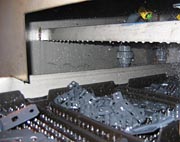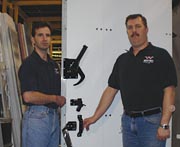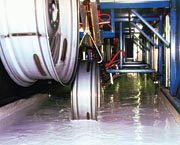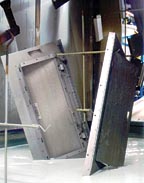The electrocoat finish is applied by dipping the parts into a tank filled with electrocoat solution, composed primarily of a resin, pigment paste and deionized water. The deposition of the coating material is the result of a series of electrochemical reactions. The cured coating film is thin but very durable and corrosion resistant. Because it is an immersion process, the coverage is extremely good with coating penetrating into recesses and areas that are very difficult to cover with spray coatings.
While we are more familiar with the electrodeposition process as a primer, there are applications where it is used as topcoat. The appearance characteristics of electrocoat materials have improved in recent years and they are sometimes used on class B and even some class A surfaces.
Typical applications include auto bodies, hidden auto parts such as oil pans, ashtrays and under-the-dash parts, metal stampings, lawn and garden equipment, wheels, agriculture equipment, fasteners, appliances, military equipment, and aircraft.
The benefits of e-coat as a primer have long been accepted and almost all automobiles include it to achieve the required level of corrosion resistance when used with zinc phosphate and subsequent topcoats. The main limitations have traditionally been the high cost of capital equipment and the limits on color change capability. The infrastructure of an electrocoat system does require a substantial investment and the dip process does not easily lend itself to a wide variety of colors within one system, but just what are the possibilities for e-coat and what new trends are in the works? To look into what is happening in the e-coat realm, we contacted some industry representatives and asked them what they see as the present and future of the technology.
As an industry expert, what are your perceptions of the e-coat industry?
Roy Goldsberry, senior electrocoat specialist at DuPont, says that the e-coat market is very competitive, especially in automotive parts, but continues to grow at the rate of the economy if not better.Lisa Merlo, senior product specialist at PPG Industries, agrees, stating that it is growing at 2 percent to 4 percent a year, and that the e-coat industry has a large potential. "The growth could be much higher if people knew and better understood the advantages of the electrocoat process and the excellent performance of an electrocoated part," she says.
And, Chuck Oakes, division manager at Whiting Door Manufacturing Corp., says, "The e-coat industry is ever changing. The new technologies in coatings being offered and the availability of smaller, more flexible e-coat systems are opening opportunities to coat products that did not exist before."
On the other hand, Christopher Metz, global product manager for e-coats at BASF, says that the e-coat market is very mature, with limited potential for growth. "Those growth opportunities will primarily arise from incremental product improvements, as most performance properties are already meeting market expectations," he says.
Bruce Rouw, vice president of sales at Therma-Tron-X Inc., believes that primers for automotive parts are getting saturated and tied to the downturn in the auto industry. He says that growth areas include replacement of plating on small parts and fasteners, some switching of coating from job shops to Tier 1 suppliers and replacement of dip spin colors with e-coat colors on fasteners. "Companies still seem reluctant to spend money on new equipment," he says. He adds that some of the companies purchasing e-coat equipment are purchasing used equipment from companies that had to shut down their e-coat operations due to the slow economy over the last few years.

What can e-coat manufacturers do in research and development areas to help penetrate the liquid market?
According to Goldsberry, because e-coat and liquid basecoat have different functions, he does not see e-coat as having a lot of opportunity to replace liquid.Therma-Tron-X's Rouw says that for e-coat to replace liquid requires large volumes of one or two colors, but only on class B product due to the inability of e-coat to hide metal defects. "Most of this market is saturated on such products as tool boxes, electrical enclosures, office furniture, etc.," he says. "Most of these liquid lines required minimal pretreatment and hide metal defects well. Better hiding electrocoat materials with superior edge coverage would help replace some liquid in class A applications." He adds that development of UV cure materials, low temperature cure materials, high film build materials for steel and possibly even plastics are areas for R&D as well as better corrosion resistance for one coat acrylic products. He would also like to see lower cure temperatures to reduce operating costs, he says.
PPG's Merlo says that current and future work is concentrating on increasing weatherability. "This would allow electrocoat to penetrate into new areas such as auto trim, aluminum extrusions, and other markets requiring durability and hardness. In essence, the industry is expecting electrocoat to approach a class A automotive finish," she says.
Metz at BASF, agrees that e-coats should be offered with UV properties. "In order to penetrate the liquid market, e-coats have to be UV-durable or at least UV-stable. In addition, e-coat manufacturers should come up with innovative application techniques that enable customers to get multiple colors from a single tank," he says.
Whiting's Oakes simply states, "The equipment manufacturers need to be able to develop systems at a reasonable cost."

In your opinion, how is electrocoating perceived as a coating technology in the industry?
Metz says that electrocoats are perceived as a mature product when looking at its product life cycle. "At the same time," he adds, "this coatings process is, together with powder applications, the most efficient paint process for parts and frames."Goldsberry at DuPont agrees. "E-coat is what you need for the best corrosion protection from a coating," he says.
Oakes believes there needs to be continued education on the benefits of electrocoating. "There are companies that need to have a better understanding of the potential benefits of e-coating, from a performance and a total savings standpoint," he says.
Merlo agrees, but her answer is somewhat more complex. "I need to break it down into three groups: Those that know about it, those that don't know about it, and those that think they know about it, but really don't."
She says that those who know about the e-coat industry find it be to a reliable, high quality, high performance coating/coating process. "They are able to get total coverage and excellent performance at low film builds," according to Merlo.
She says those who think they know about it regard e-coat as a "high tech, sophisticated, too-difficult-to-handle process."
"Really the opposite is quite true," Merlo notes. "Process efficiencies typically lead to less labor demand. Excellent coverage leads to higher performance. And closed-looped rinsing leads to 95 percent to 98 percent efficiency. That means 95 percent of the material in a gallon of paint actually gets coated onto the part - no overspray, very little waste."
Merlo refers the group that doesn't know about e-coat to contact the Electrocoat Association to learn about its benefits.
Rouw says e-coat is perceived as having excellent corrosion resistance as a primer but more expensive than liquid or powder. He says the perception is that it is not suitable as a single-coat finish for most class A applications as well as an expensive capital equipment investment limited in color changing, and limited in market applications.
He states,"[E-coat] is the best coating on the market for corrosion resistance but limited to high volume applications because of expense and difficulties in running multiple color systems. I think some have the perception that an electrocoating operation is more difficult to run because of specialized knowledge requirements."

Emerging markets offer opportunity for e-coat. Where is the coatings business shifting or growing?
Goldsberry says that emerging markets are driven by low cost as all markets are, but sometimes more so because there is less money for the general population to spend. These markets are seeing that longer life is a way of reducing lifetime cost for goods and e-coat can help there.Merlo believes that there are really two emerging markets for electrocoat applications: bulk coating of small parts/fasteners and clears over anodized aluminum or plated parts.
"Most small parts are coated on racks. Loading and unloading racks can be very labor intensive leading to high labor costs," she says. She offers that PPG has developed bulk electrocoating, which takes the loading/unloading part away from the coating process. "The parts can be dumped into barrels, baskets, or onto a belt," she says.
She notes that clear electrocoat provides a protective coating onto plated or anodized aluminum parts and that clear electrocoat provides one or several of the following qualities based on the chemistry utilized: aesthetic qualities, UV durability, detergent resistance, chemical resistance, and corrosion protection. "Jewelry will no long turn green. Anodized aluminum used on buildings and window will retain its appearance or finish longer," Merlo says.
Metz says that the highest growth rates will come from the Asian and Latin American regions. "This growth is mainly driven by the increasing OEM production in these regions, but also through a shift of Tier business to these areas. Latin America will see a growth in Tier business, as the main focus in the parts business is on reducing cost," he says.
Rouw predicts Eastern Europe and China will see the most growth.

In which industry sectors do you think growth opportunities lie?
Whiting Door's Oakes says these opportunities lie in the truck and trailer market. "These are areas where corrosion is becoming a big problem because of chemicals being applied to roads. The need to better protect metal parts is becoming increasingly more important in these industries, where warranties are being extended," he says.Rouw says he believes that with current technology, hardware goods, bulk fasteners, architectural products, construction equipment and automotive are where we will see growth.
Merlo states that the automotive parts and accessories (APA) and appliance markets are growing at approximately 2 percent to 4 percent. "Growth lies in the new industry segments such as clears and the bulk coating of small parts and fasteners," she says, and adds that clear growth is estimated at 5 percent to 7 percent.
Metz at BASF says, "Overall, we think that the Tier segment will have the biggest potential for growth in e-coats."
Is there developing technology that will improve e-coat color options? What about technology that would allow e-coat color changes to be possible at a reasonable cost?
Therma-Tron-X's Rouw says that there is equipment available that allows rack by rack color selection for six to eight colors per line. Although DuPont's Goldsberry mentions that color change remains tough for e-coat. "It is very difficult and expensive to change the paint, including color change, in an e-coat system," he says.
Merlo points out that electrocoat formulations that utilize mica pigments (copper, silver) providing a metallic look used in products such as fasteners and hangers are currently available. She says that dyes also are utilized for applications where UV durability is not important. "New technology allows for the use of pigments in clears without affecting opacity and also exhibiting very good UV durability. There are also some equipment options that could be incorporated into a system to include the possibility of multiple color tanks," she adds.
Where do you foresee e-coat growth in the market to be? (e.g., e-coat primer, e-coat primer and topcoat, e-coat topcoat, e-coat primer with other finish topcoat)
Goldsberry says he believes there is some growth in all those areas. Merlo expects most of the growth to come from using an e-coat primer with other finish topcoat.Metz says that BASF sees growth opportunities for e-coats mainly in the Tier market, primarily due to outsourcing and job coating trends in this area. And Rouw says he sees e-coat primer replacing plating and topcoat colors for fasteners and multicolor operations.
Oakes also says that as more colors become available at reasonable cost, e-coat as a topcoat should offer more opportunities in the market.

In the next three years, do you think companies will add e-coat lines or outsource e-coat?
Goldsberry says that DuPont sees a trend of adding e-coat lines for better cost, quality, and delivery control. Metz says that BASF sees a saturated market in the OEM segment, so additional lines will primarily come from job coaters and expanding ASM suppliers in the Tier segment.Merlo, Rouw and Oakes all believe that both will occur. According to Merlo, "Approximately 50 new tanks are filled every year with e-coat. I believe this will continue for companies that have the volume to justify an e-coat system. For smaller companies, utilizing a jobber is an excellent way to get parts electrocoated by experts in the field."
Oakes says that many companies do not want make the initial capital investment that an e-coating system requires. "They may not want to have the responsibility of running a system daily. Some manufacturers will choose to install their own equipment as the cost of equipment comes down and their volumes justify the savings obtained from outsourcing this service," he says.
Rouw sums it up. "Add e-coat lines if the volume is adequate, outsource if not." Because the cost of products become a major factor in the market, companies will try to outsource as much as they can, he says, until transportation becomes a big role in their product cost. "Many users would rather do it themselves if they had supervision and a way to calibrate their consistency and quality so they can reduce cost," Rouw says.
What are the trends in e-coat technology?
Goldsberry and Rouw both agree that better edge coverage is one trend. Goldsberry also mentions lower cure temperatures and Rouw talks about anti-stick properties for fasteners as well as a movement toward more environmentally friendly products.Metz believes that the environmental requirements - low VOCs, HAPs-free and lead-free requirements that have been the drivers for e-coat development - have all been met. He says, "Future e-coat development will be more application-driven than product-related."
Oakes sees the trends including more color options and products that provide better performance and higher film-builds, at a lower applied cost.
What are the trends in the application of e-coat?
Merlo mentions PPG's development of bulk electrocoating as the newest application method. She says, "Utilizing a bulk process is the best way to coat many small parts or fasteners at one time instead of individually racking them."
On the other hand, Rouw says he believes that smaller lines taking up less floor space with dense racking and reduced costs is where application trends are heading. Metz agrees. "The main trends for e-coat application developments are reducing the footprint of the operation and the overlap of phosphate and e-coat systems."
What is needed for electrocoat industry growth?
Merlo and Oakes both agree that awareness of electrocoat through education is key. "If people know about the strengths of electrocoat, they will find a way to use it by either putting in their own system or finding a jobber close by to handle their parts," says Merlo.According to Oakes, "Continued education and promotion on the benefits of e-coating are needed for growth. The development of automated systems at a reasonable cost, which will reduce labor cost and produce quality parts with increased performance characteristics, are what is needed," he says.
Metz says the push for further electrocoat industry growth will depend on the growth in the OEM markets because there is a direct correlation between the two industries. He says, "Furthermore, the ability to implement the incremental improvements of the product and application ideas mentioned earlier will impact the growth opportunities of this industry."
Rouw offers the last words with a very real and on-target observation. He says what we need is "more manufacturing in this country, less purchasing of manufactured goods from other countries, and better balance of trade policies of our federal government; improved education of the general industrial finishing decision makers on the advantages of e-coat; e-coat materials that have additional advantages vs. powder and liquid; and reduced equipment costs for electrocoating systems."
As you can see from the answers, there are still some opportunities for growth into new areas for e-coat. Lower VOC levels and new finishes have added to the proven advantages of high material utilization and excellent corrosion resistance. Growth is likely to continue but the global economy is challenging the e-coat industry just as it is every other manufacturing sector in the United States.
For more information about the process and opportunities in electrocoating, contact the Electrocoat Association at 800-579-8806 or visit www.electrocoat.org.

Report Abusive Comment